More Than Just a Flower: The Orchid’s Manifold Faces
Senior Librarian Ang Seow Leng gives us a crash course in all things orchids and their special relationship with Singapore.
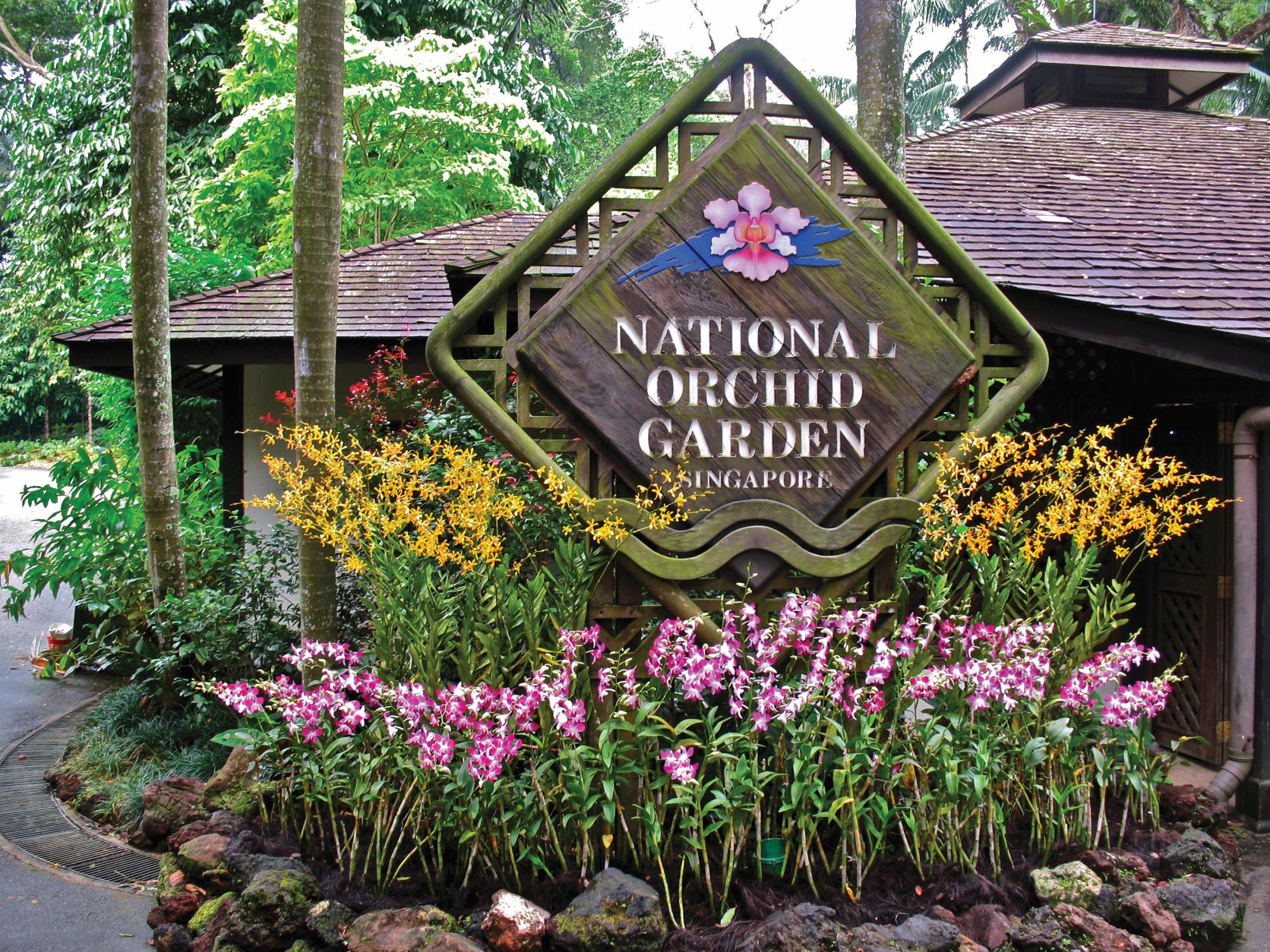
The 20th World Orchid Conference will once again be held in Singapore from 13–20 November, at the Marina Bay Sands Expo and Convention Centre. This major event is regarded as the “Olympics of Orchids”. World Orchid Conferences were initiated in 1952 by Gordon W. Dillon from the American Orchid Society. He was also the editor for the American Orchid Society Bulletin from 1943–1967 and from 1970–1973. The first conference was held in St Louis, Missouri, in October 1954. Since then, it has been held once every three years. Regarded as the most significant event in the international orchid circuit, it attracts academics, orchid breeders and enthusiasts who gather to share about the promotion, cultivation and study of orchids.
The 4th World Orchid Conference was held in Singapore from 3–10 October 1963. It was jointly sponsored by the Malayan Orchid Society, Royal Horticultural Society and the American Orchid Society. This first major orchid event hosted in Asia included an orchid show at the Singapore Turf Club, a proud showcase of the rich variety of orchids from all over the world. The event attracted 700 delegates from 45 countries.1
Parade of Orchids
Flower shows have had a long history in Singapore. According to The Straits Times, they were held in Singapore in 1884–1900 and 1931–1937. When the Singapore Gardening Society was formed in 1937, they took over the organising of flower shows till 1941, when the “Grow More Food” show took their place.2 Orchids were the mainstay in these shows. The flower or horticulture shows continued after the war, growing in magnitude and scale. Apart from domestic exhibitions and events, Singapore’s orchid hybrids also participated in overseas competitions.
Singapore’s inaugural international garden and flower show was held in December 2006. Known as the Singapore Garden Festival, it was a major attraction that welcomed approximately 200,000 visitors3 throughout the event. The visitor numbers kept increasing for the subsequent Garden Festivals held in 2008 and 2010.
Competitions to judge award-winning orchids are common in flower shows. Cups, medals and other special prizes have been awarded to the winners ranging from gardening hobbyists to firms in the horticulture industry. The oldest awarding body for orchids is the Orchid Committee of the Royal Horticultural Society.4 It classifies its awards as follows: First Class Certificate, Award of Merit and Highly Commended Certificate. In Asia, the oldest awarding organisation is the Orchid Society of Southeast Asia.5
According to Teoh Eng Soon, an orchid enthusiast, awards from these particular societies are most highly valued: the Royal Horticultural Society, American Orchid Society, Orchid Society of Southeast Asia, Orchid Society of Thailand, Hawaiian Orchid Society, South Florida Orchid Society and the Australian Orchid Council.6 These awards recognise the best orchids grown, encourage research and reward the growers and breeders for their efforts.
Orchids – More Than Just a Flower
Orchids have enjoyed admiration from generations of artists, gardeners and philosophers. Confucius said, “acquaintance with good men was like entering a room full of fragrant orchids. One barely notices the scent, but as time passes a subtle influence will be exerted to one”. 7 There is even has a legend attributed to one of its species. According to the Javanese, the foliage of the Macodes petola (also known as jewel orchid, famed for its striking leaf patterns) arose from shreds of a magic silk scarf that had been placed on jagged rock by a beautiful goddess.8
The orchid family, Orchidaceae, is one of the largest families of flowering plants and has about 25,000 species. With the sheer amount of the species under this family, some are still waiting to be discovered, while new species are being found and hybrids being created all the time. The orchid derives its name from the Greek term, orchis, meaning “the testicles”, an association made by Theophrastus (c. 370–c. 287 BCE), with reference to the shape of the root tubers of species in Greece. Theophrastus was a Greek philosopher who wrote two large botanical treatises, History of Plants, about classification and distribution, and Causes of Plants, dealing with structure and physiology. Later, Carl von Linnaeus (1707–78), a Swedish naturalist and physician, who is well known as the “Father of Plant Taxonomy”, retained this name in his Species Plantarum (1753), which introduced the concept of binomial nomenclature.9
Orchids can be commonly found in homes, hotels and offices. Flourishing in all parts of the world, they come in different colours, shapes and sizes, and can be found growing in a wide range of environments. Teoh summarised it best when he drew attention to the resemblance of orchids to insects and even slippers:
“ There are orchids which resemble moths (Phalaenopsis),
butterflies (Psychopsis papillo), the slippers of Aphrodite or
moccasins (Paphiopedilum and Cypripedium), dancing ladies
(Oncidium), spiders (Brassia), scorpions (Arachnis) and bees
(Ophrys). “10
Orchids also have several uses in addition to being ornamental plants. The vanilla seed capsule is a common ingredient used in baking. Derived from the Vanilla planifolia, it is also used in beauty products like perfume and aromatherapy oils.
Certain orchids are also used for food or food supplements. For instance, the leaves of one species, Anoectochilus, have been sold as a vegetable in Malaysia, and the leaves of the Dendrobium salaccense are cooked and added as a seasoning with rice. In 2005, chef Choo Kwang Keong tried to introduce the eating of orchids in Singapore. Classes were held at the Mandai Orchid Garden as part of the Singapore Food Festival, to teach people how to cook with orchids.11
Some orchids have been used in folk medicines and cures. In the Malay Peninsula, women in Malaysia would make a drink from the boiled leaves of the Nervilia aragoana to prevent sickness after childbirth. In Melaka, boils are treated with a poultice made from the Oberonia anceps.12 In India, there has been studies on some orchids as traditional medicine.13
Singapore Botanic Gardens – The Powerhouse for Orchid Hybridisation Research
The Singapore Botanic Gardens played a pivotal role in spearheading orchid research and conservation. However, orchids had been an object of study in Singapore even before the Gardens’ establishment in 1859, such as that by the Agri-horticultural Society, a private body, that had been active in orchid cultivation. There was mention of a “derelict orchid house” that was inherited when the Botanic Gardens took over from the Society.14
The variety of tropical orchids has been a fascination for horticulturalists. Records of plant exchange at the Gardens from 1875 onwards showed a high frequency of species being sent to all parts of the world. The Gardens’ earliest records note that the Superintendent of the Gardens, H.J. Murton, began to cultivate orchids in a newly constructed Orchid House during the mid-1870s.15 However, orchid thefts and pilfering became so rampant that by 1879 Murton reported that “the larger part of the Orchidaceae has been removed and fixed on trees beyond the reach of visitors to prevent their being stolen”!16
Henry Nicholas Ridley, the first Director of the Singapore Botanic Gardens from 1888 to 1912, also contributed to the identification of orchids in Malaya. When collecting plant specimens, he made conscious effort to collect orchids for the herbarium for the purpose of study, cultivation and exchange. Published records show that he described 13 orchid genera and about 200 new species. In 1893, he described the first orchid hybrid, Vanda Miss Joaquim, and in 1896 he wrote the first account of orchids in the Malay Peninsula.17
The Singapore Botanic Gardens, under its third director, Richard Eric Holttum, was the sole organisation to be actively involved in producing orchid hybrids. Holttum was with the Singapore Botanic Gardens from 1922 to 1949. He was regarded as a pioneer for creating orchid hybrids in this region and for his work in the experimental cultivation of orchid seedlings in Malaya in 1928. The first hybrid, Spathoglottis Primrose, flowered in 1931,18 ushering in an era of active orchid hybridising in Malaya. The second orchid hybrid to flower after Vanda Miss Joaquim, Spathoglottis Primrose was germinated on artificial media. It was the first successfully grown hybrid in Singapore using what was known as the Knudson’s method. Holttum registered 28 hybrids during his tenure with the Gardens. Another major contribution from him was the book, Orchids of Malaya, which was published in 1953 and features more than 750 Malayan orchid species.19 It is still regarded as an important reference today.
After the Japanese Occupation, the creation of Malayan hybrids began to pick up speed in 1949, with the landmark flowering of Vanda Tan Chay Yan in 1952.20 This particular hybrid was awarded a First Class Certificate, the highest award given by the Royal Horticultural Society of the UK, at the Chelsea Flower Show in England in 1954.21
The Tissue Culture Laboratory was established in the Gardens in the early 1970s to experiment on tissue culture of orchids. By 1978, the laboratory started a service to assist local orchid growers and breeders.22 Economically driven, the laboratory contributed to the mass propagation of selected orchid hybrids to enable the local orchid industry to gain an edge over competition from Thailand and Malaysia in the cut-flower market. Free-flowering and robust orchid hybrids that last long in vases were the preferred choice.
The Orchid Enclosure was opened to the public in 1955. The hugely popular enclosure was expanded over time, and the National Orchid Garden was opened at the end of 1995 which exhibited an extensive range of orchids. In order to cultivate and research the orchid species growing in higher altitudes and from temperate climates, the Cold House, also known as the Temperate House, was built in 1972. In 2004, it was replaced by the Cool House Conservatory, which was constructed in the National Orchid Garden.23 As at 2009, Tan Wee Kiat reported that there were more than 1,000 orchid species and 2,000 hybrids in the collection.24 The Gardens has also registered more than 400 hybrids.25
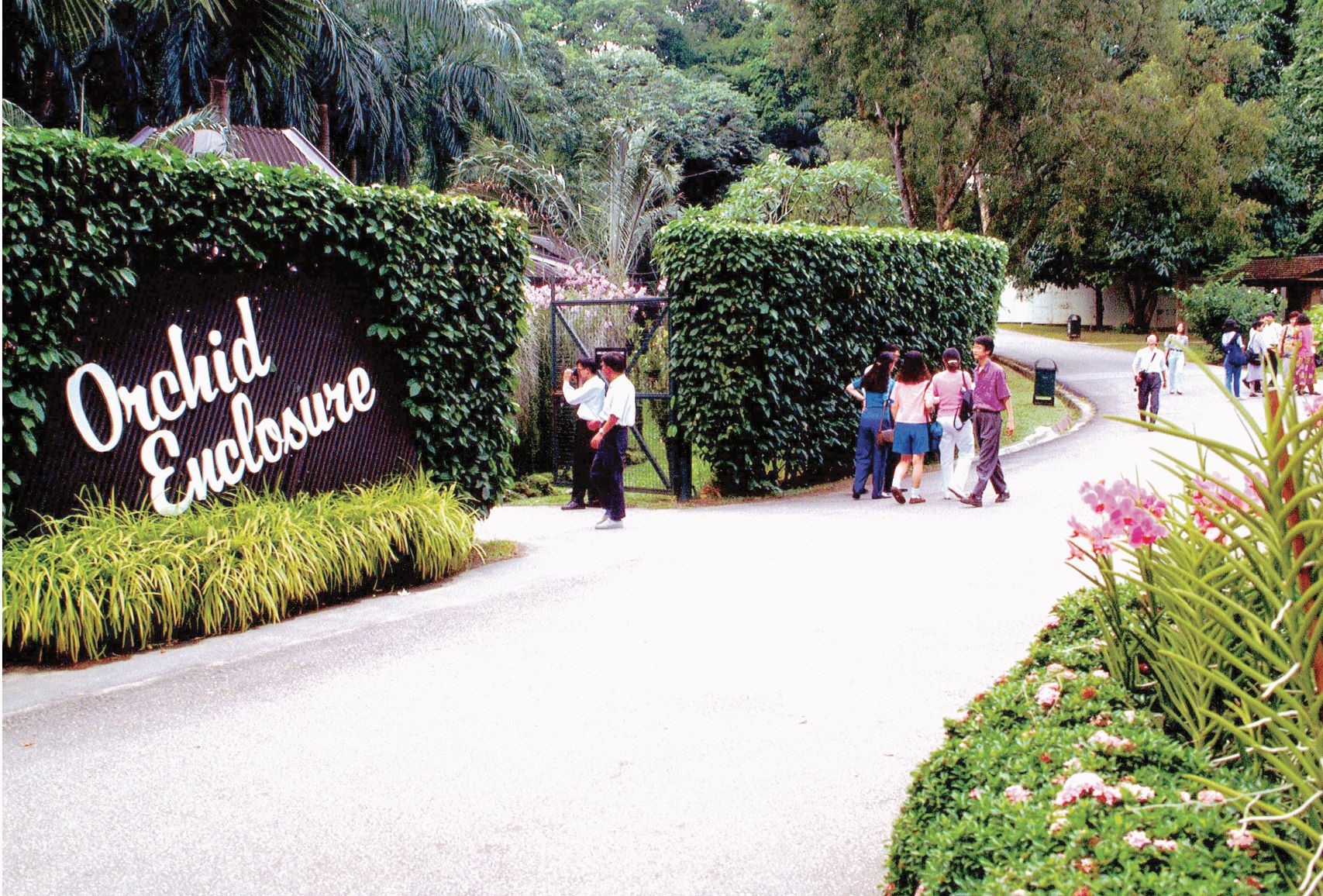
Saving Native Orchids
More than 90 percent of the 221 species of Singapore’s native orchids have become endangered, vulnerable, rare or extinct.26 In 1991, a programme was started to conserve the orchid species of Singapore. These native orchids were slowly becoming extinct due to aggressive urbanisation and diminishing natural habitats. Three main strategies were proposed:
a. Artificial propagation
b. Reintroduction to habitats
c. Foundation of a seed bank27
As a result, the tiger orchid, or Grammatophyllum speciosum, was the first species to be reintroduced in Pulau Ubin and it has since taken root and is doing well. As at 2007, four native orchid species have been reintroduced in parks and roadside trees.28 Research and conservation continue to be the main objective at the Singapore Botanic Gardens in order for future generations to enjoy the beauty of orchids and discover other uses for them.
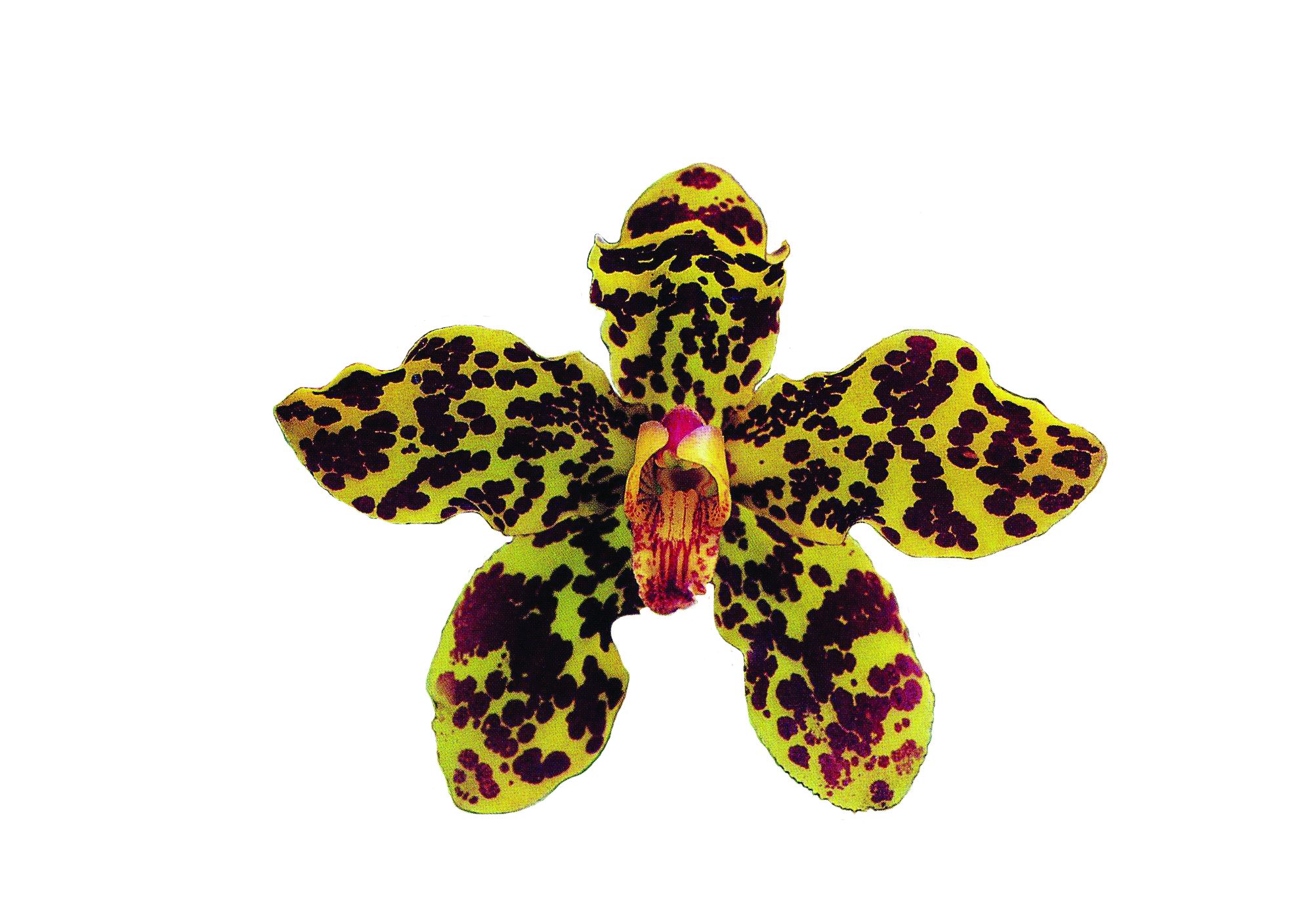
A Symbol of Singapore
The orchid is a well-recognised symbol of Singapore, and Singaporeans should be familiar with the name of our state flower – Vanda Miss Joaquim. It was propelled to international prominence when it won the First Class Certificate at the London Royal Horticultural Show in 1897 and the first prize at the 1899 Flower Show in Singapore. According to Teoh Eng Soon’s Asian Orchids, he credited this hybrid in pioneering the Southeast Asia orchid industry.
In 1981, it was chosen as Singapore’s national flower after a yearlong search picked from a selection of 30 other orchid hybrids, the justification was that it is a common, resilient species with year-round blooming capability.29 How this orchid hybrid came about has not yet been resolved. It was first recorded by Henry N. Ridley, then Director of the Singapore Botanic Gardens, in The Gardener’s Chronicle (1893) as a cross between two species of orchid, Vanda hookeriana and V. teres. However, there was no mention of which was the male parent. To solve this mystery, the Singapore Botanic Gardens is currently conducting DNA research to ascertain the parentage of the orchid.30
Designing the national dress for Singapore has always been a challenge. Should it be a creative expression of highlights in the Chinese, Malay and Indian ethnic costumes? The results of such attempts do not always leave a favourable impression on people. Then President Ong Teng Cheong suggested creating a national dress based on the national flower.31 This started a buzz and several new lines of fashion, ranging from orchid-themed cheongsams to swimwear and gowns created by international and local designers.
In 1992, the Singapore Dress Development Committee narrowed the range of orchids as design motifs to five: Vanda Miss Joaquim, Oncidium Gower Ramsey, Dendrobium Tay Swee Keng, Renanthera Kalsom and Phalaenopsis Barbara Bush. By 1994, Vanda Miss Joaquim was made the theme of the Singapore dress collection. As quoted in the Straits Times,
“ Dendrobiums may look more vibrant and golden showers
more exotic but it’s been va va Vanda that’s got the voom
for every designer who’s worked on Singapore dress. “32
Over the decades, orchids have been a common motif on Singapore stamps. Between 1962 and 1966, the Fishes, Orchids and Birds Definitives series featured the Arachnis Maggie Oei, Vanda Tan Chay Yan and Vanda Miss Joaquim. The 1976 Orchids of Singapore series featured four different orchids, while another four orchids were featured in the 1979 Orchids of Singapore series. More orchid series appeared on an annual basis from 1991 to 1995, in conjunction with the Singapore World Stamp Exhibition, which was held in September 1995. The 1998 Singapore-Australia Joint Issue series had the moth orchid, bamboo orchid, tiger orchid and Cooktown orchid as motifs. Vanda Miss Joaquim was featured again in the 2003 Garden City series. As recent as 2009, pigeon orchids were featured on stamps, and the first-day cover commemorating the 150th anniversary of the Singapore Botanic Gardens also featured orchids. More orchid stamps can be expected in the future.
With the establishment of the Board of Commissioners of Currency in 1967, the first paper notes in Singapore also featured orchids as the main design theme. They were issued between 1967 and 1976. After that, the Orchid series of currency notes was replaced by the Bird series. During the release of the Floral series coins in 1985, Vanda Miss Joaquim was featured as the reverse design of the one-cent coin.33
The Singapore Mint also introduced a Heritage Orchids of Singapore coin set that were produced for five years from 2006 to 2010. It produces two sets of coins per year, featuring orchids that have heritage value. These coins have enjoyed popularity among coin collectors.34
Orchid Diplomacy
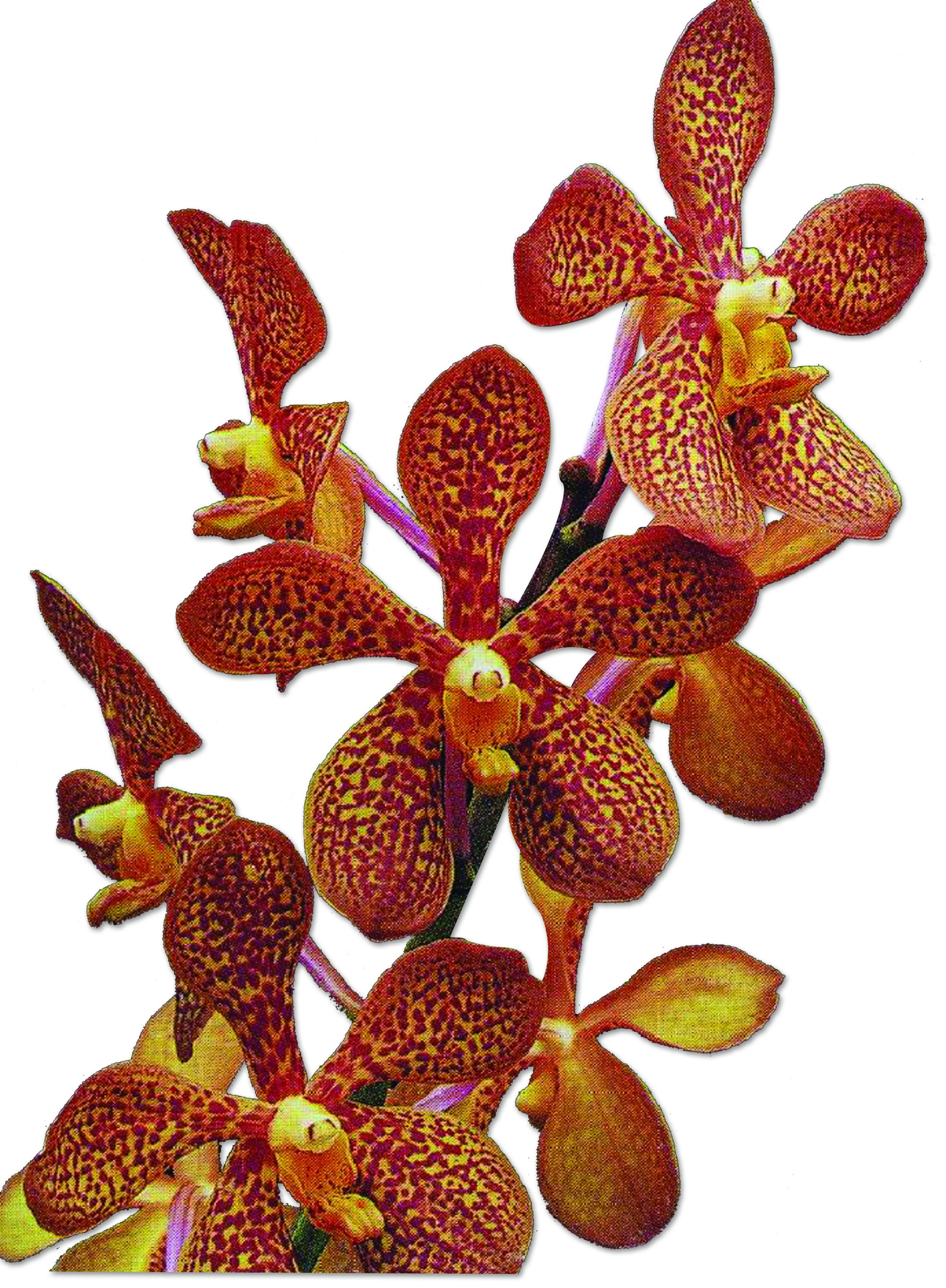
With Singapore orchids gaining fame in the world, it was adopted as an agent to promote goodwill with other nations. The Singapore Botanic Gardens started the practice of naming of new orchid hybrids after VIPs and visiting celebrities. In 1956, Aranthera Anne Black became the first VIP orchid, named after Lady Black, the wife of the former Governor of Singapore, Robert Brown Black.35 Other orchid hybrids named after VIPs include: Dendrobium Michiko, Mokara Zhu Rongji, Renantanda Prince Norodom Sihanouk, Dendrobium Memoria Princess Diana and Vandaenopsis Nelson Mandela. Some are named after celebrities, like local singer Stephanie Sun, pop music celebrity Ricky Martin and Korean actor Bae Yong Jun.
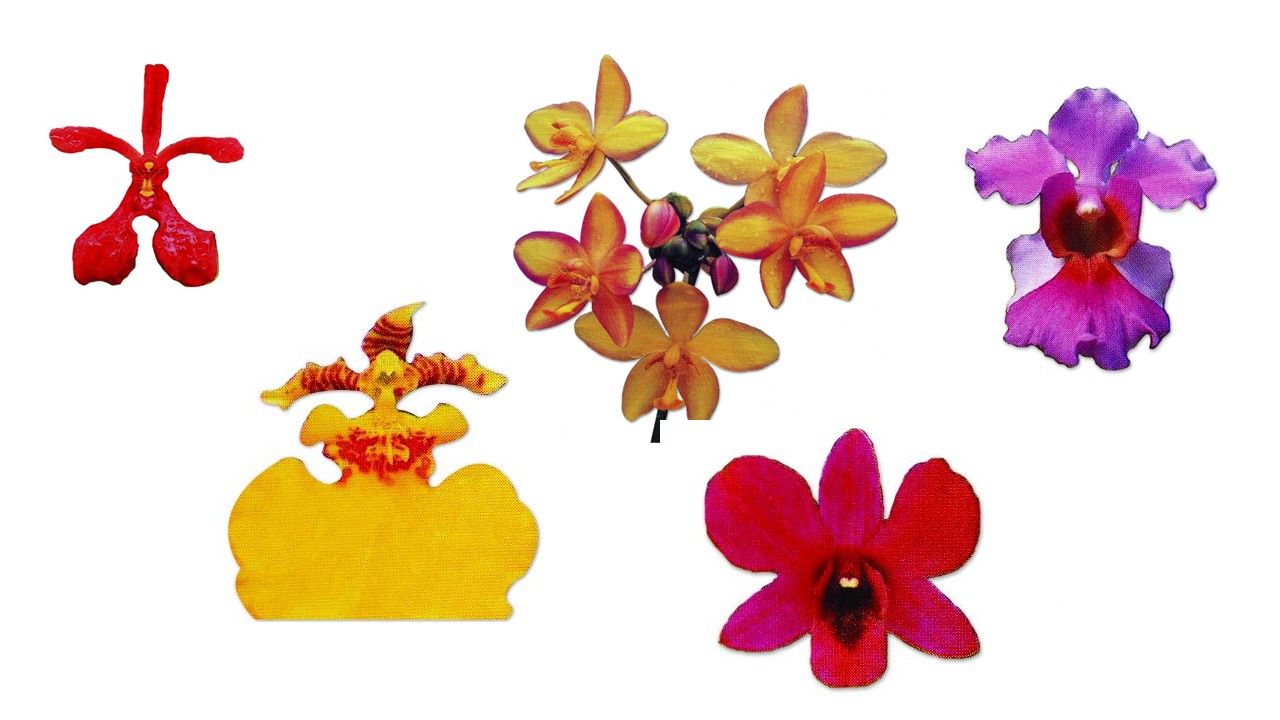
The orchid was also endorsed by David Marshall, Singapore’s first Ambassador to France, and subsequently to Spain, Portugal and Switzerland. He was well known as the ambassador with an orchid as he would wear an orchid on his lapel at every official function.36
Mention Risis orchids and most people will think of the beautiful gold-plated orchid ornaments. The former Singapore Institute of Standards and Industrial Research (SISIR) developed and perfected the technique of preserving orchids in 24K gold in 1976. It all began with the search for a national souvenir for Singapore after independence. Lee Kum Tatt, the founding chairman of SISIR, had a brainwave in 1969.37 Recalling his wife’s whimsical remark, wishing that orchids would last forever during one of their strolls through the Botanic Gardens in 1955, he set about creating and perfecting the technique of gold-plating an orchid to lock in its beauty. This was some 20 years after she had made that remark! Since then, Risis orchids have been presented as gifts to visiting foreign dignitaries like Queen Elizabeth II and Japanese Empress Michiko.38 They are also popular souvenirs among tourists.
The 1981 Cultural Medallion winner for excellence in painting orchids, Lee Hock Moh, has been expressing the beauty of orchids through his Chinese brush paintings. Tommy Koh once commented that Lee’s paintings are “technically superb and stylistically unique”.39 It was Lee’s art teacher who encouraged him to paint orchids instead of flowers that are not found here. It was not difficult for Lee to do so as he grew up with orchids at his family’s house where numerous orchids were grown. Many of his artworks were presented as gifts to heads of state from all over the world. The paintings lend an hand in promoting orchids as our national flower and in establishing goodwill with these countries.
A Pot of Gold?
For Singapore, the major economic contribution of orchids is the cut-flower export industry. Singapore’s tropical climate enables the production of orchids all year round whereas countries with four seasons have to grow their orchids in greenhouses. The Monetary Authority of Singapore announced in a 2006 press release40 that Singapore is one of ASEAN’s top producers and exporters of top quality orchid flowers, supplying about a 15-percent share of the world’s market in orchids. In 2004, Singapore exported S$29.08 million worth of orchid cut-flowers worldwide. During the 1970s and 1980s, the industry was worth as much as S$16 million per annum.41 Today, Singapore is the third-largest exporter of orchids in the world.42
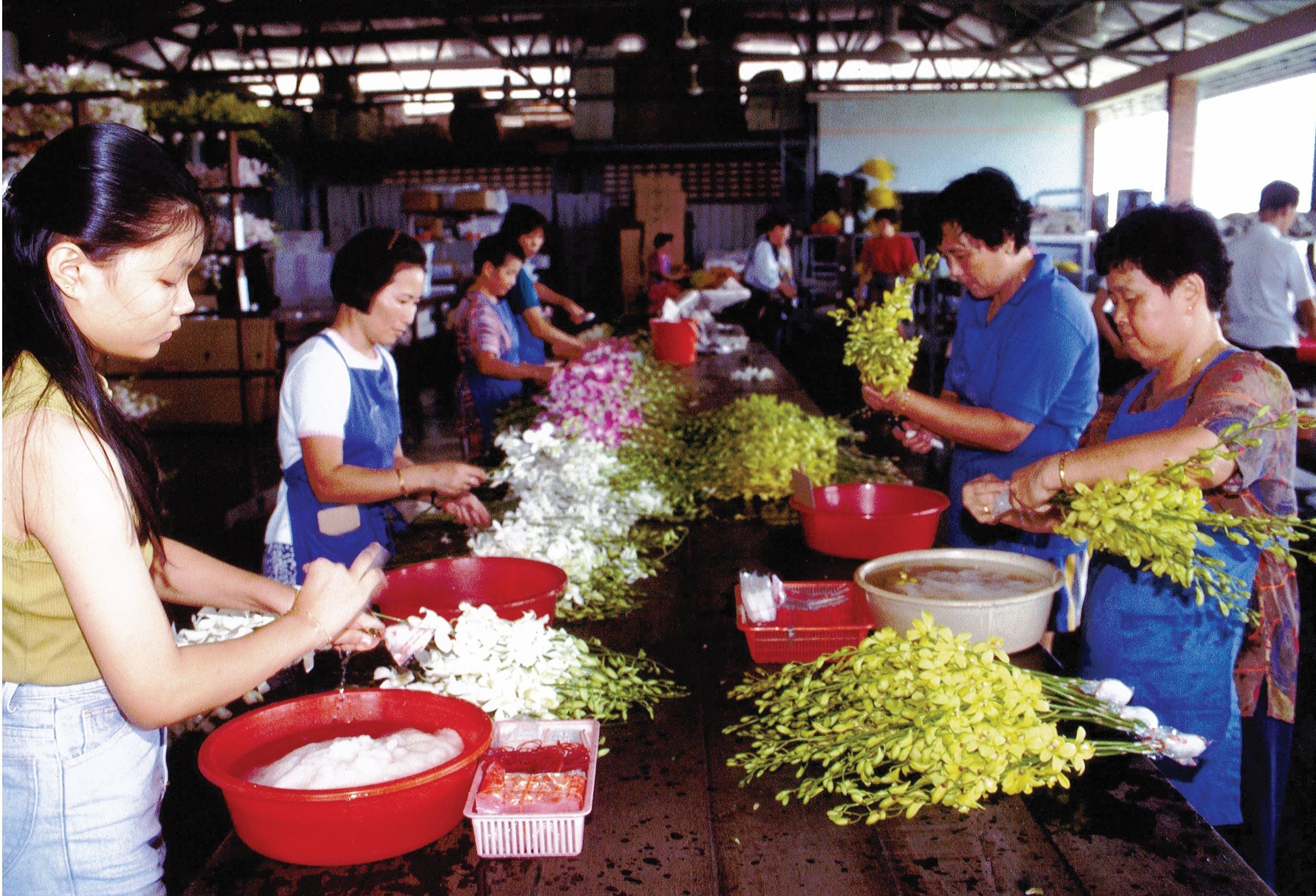
Orchid exporting in Singapore began in the 1930s. The preferred orchids then were the Vanda Miss Joaquim, which was the first to be exported on a large scale, followed by the Cattleya family, including Laelias and Brassavolas.43 Subsequently, it became more profitable to propagate orchids that flower more frequently in order to meet market demands. The ornamental value of long-lasting orchid flowers made them suitable for export as cut-flowers.
A typical batch of orchids to be prepared for export in the early days was described as follows:
“ The crates of light bamboo each contained 25–30 stalks,
sprayed with insecticide, wrapped in damp cotton-wool and laid
on a bed of banana leaves. “44
Amateur orchid collector and grower John Laycock, who co-founded the Malayan Orchid Society (present-day Orchid Society of South East Asia) with Emile Galistan and Holttum, founded Singapore Orchids Ltd (also known as Mandai Orchid Garden45 in recent years) with Lee Kim Hong in 1951 to realise his vision of starting an orchid cut-flower trade on a commercial basis. The company became well known and is the oldest orchid garden establishment in Singapore.
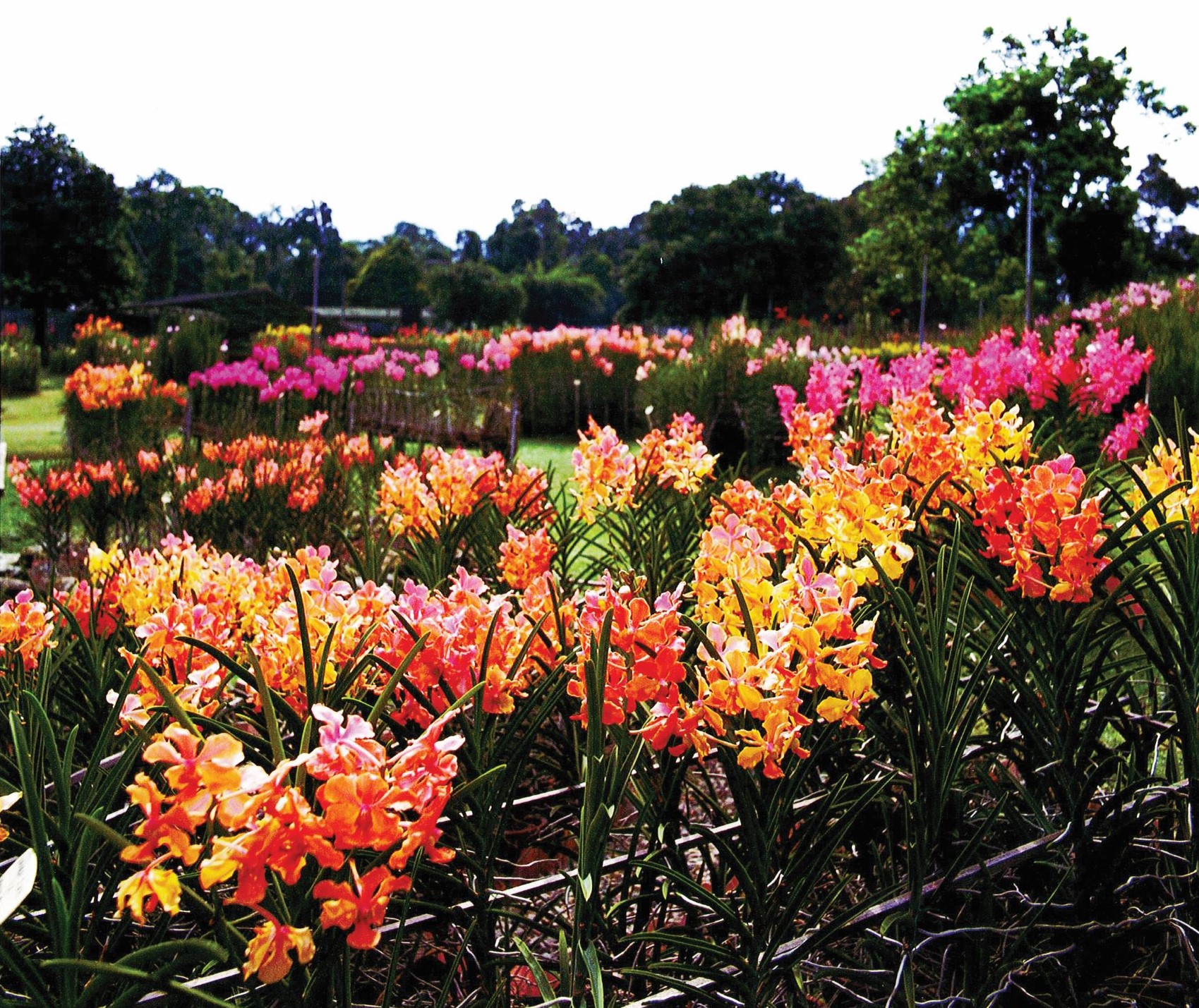
The orchid flower export industry has grown from strength to strength through the increasing ease in air transport and efforts put in by the Tourism Promotion Board. In 1966, President of the Singapore Gardening Society, the late A.G. Alphonso, reported a happy problem of local florists and nurseries not being able to cope with the demand for cut-flowers from overseas, especially from European countries. The private gardens and amateur orchid growers began to find it a “profitable pastime”.46
The golden age of orchid exports lasted from the late 1960s till the mid-1980s. During its peak from the late 1970s to early 1980s, there were approximately 230 nurseries involved in this industry. In 1970, close to 71 hectares of land were used for orchid cultivation and the acreage doubled to 138 hectares in 1972.47 By 1980, it continued to increase five-fold to 350 hectares, but it reportedly suffered decline in acreage from 1983 onwards.48
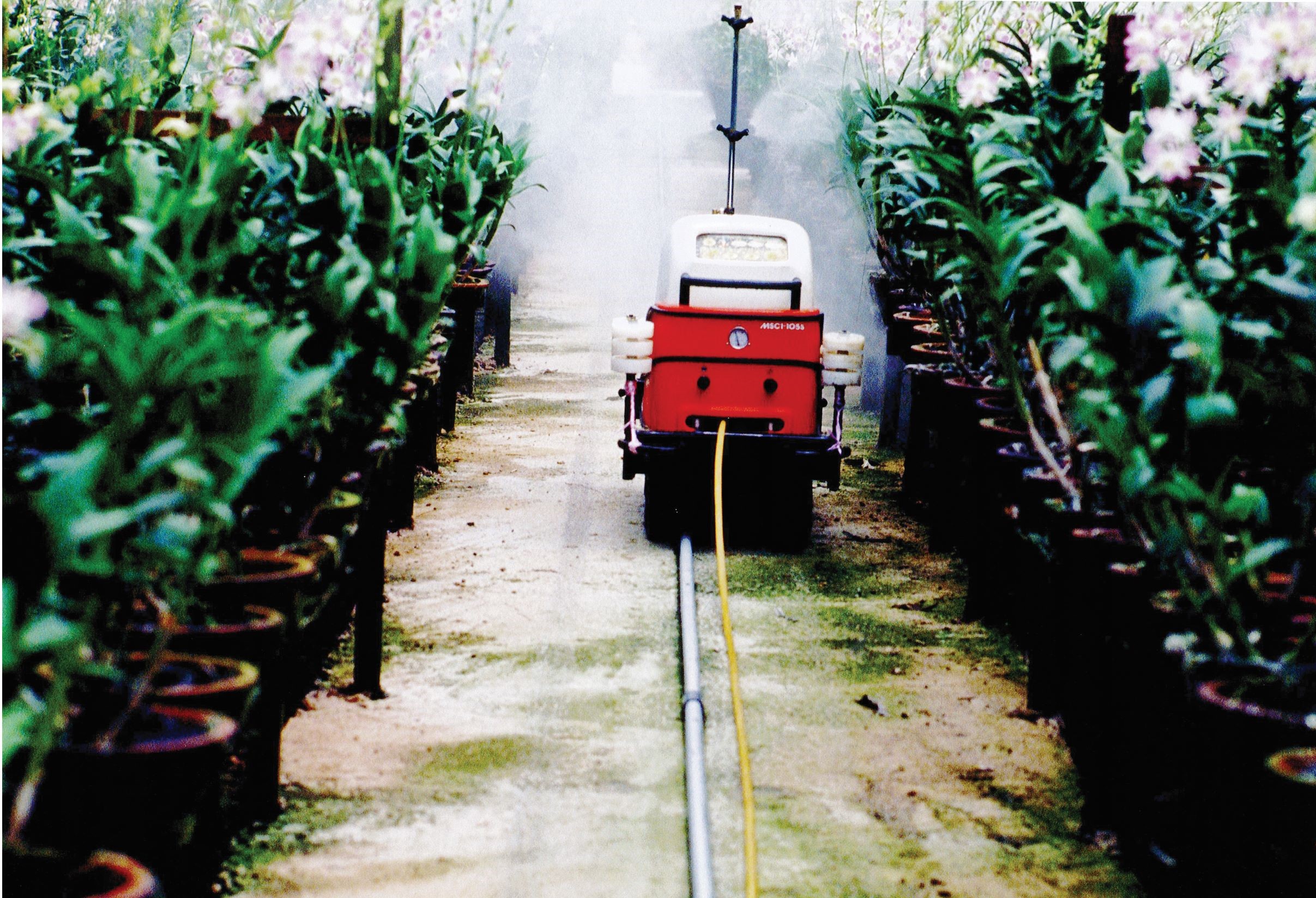
In 1986, the Agri-Food & Veterinary Authority of Singapore (AVA) developed agrotechnology parks to encourage farms to embrace advanced technologies and techniques for intensive farming systems. These farms aim to optimise land use and increase productivity. There are six such parks in Singapore49 and some of these parks have orchid farms whose businesses continue to thrive.
With the financial crisis in the recent decades and the shrinking land for orchid cultivation, the future of the orchid export industry appears to be uncertain. During 2003, the Orchid Business Cluster was established by the AVA to strengthen Singapore’s position as a world-renowned exporter of tropical orchids through coordination of the entire value chain of orchid growers and exporters, and to develop strategic plans to move the industry forward.
In a highly urbanised country, competing spaces for a myriad of uses result in the rapidly disappearing natural habitat of orchids and diminishing gardens to plant these lovely flowers. While new hybrids have been developed to suit different growing conditions for the orchids, and to meet the cut-flower market demands, it is a challenge to sustain the appreciation for orchids among people and their memories of past generations of orchid hybrids that were once the pride in people’s home gardens. The coming World Orchid Conference can be an impetus for reintroducing people to the fascinating world of orchids.
For new information regarding the origin of Vanda Miss Joaquim, see “Blooming Lies: The Vanda Miss Joaquim Story”.
To find out more about the practice of naming orchid hybrids after visiting heads of state and foreign dignitaries, see “Flower Power: Singapore’s Orchid Diplomacy”.
 Ang Seow Leng
Ang Seow LengSenior Librarian
National Library
REFERENCES
“700 To Attend Tomorrow’s Orchid Talks,” Straits Times, 7 October 1963, 6. (From NewspaperSG)
Amy Ede and Jane Ede, Living With Orchids (Singapore: MPH Magazines, 1985). (Call no. RSING 635.93415 EDE)
Ang, Seow Leng, “Icon of justice: Highlights of the life of David Saul Marshall (1908–1995),” BiblioAsia 4, no. 3 (October 2008)
Cat Ong, “Orchid Blooms,” Straits Times, 23 July 1998, 6. (From NewspaperSG)
Cat Ong, “Vanda’s Not Joking,” Straits Times, 11 July 1999, 6. (From NewspaperSG)
“Demand for Blooms from S’pore Is Growing,” Straits Times, 5 March 1966, 4. (From NewspaperSG)
Diana Othman, “Risis Orchid Creator Dies of Heart Attack,” Straits Times, 7 June 2008, 72. (From NewspaperSG)
Ee Jamie Wen Wei, “Mandai Orchid Garden to Move to Kranji,” Straits Times, 1 January 2011, 9. (From NewspaperSG)
Encyclopedia Britannica, “Orchid,” accessed 5 September 2011, http://www.britannica.com/EBchecked/topic/431285/orchid.
Gracie Lee, Richard Eric Holttum, Singapore Infopedia, published 2016.
H. M. Burkhill, The Role of the Singapore Botanic Gardens in the Development of Orchid Hybrids (Singapore: Straits Times Press, 1963). (Call no. RCLOS 584.15 BUR)
“Hybridisation Programme,” Singapore Botanical Gardens, accessed 5 September 2011, https://www.nparks.gov.sg/sbg/research/orchid-breeding-and-reintroductions/orchid-hybridisation-programme.
Ian Turner, “Carl Linnaeus (1707–1778) – Father of Systematic Biology,” Gardenwise 28 (January 2007): 6. (From BookSG)
Jeewan Singh Jalal, Pankaj Kumar and Y.P.S. Pangtey, “Ethnomedical Orchids of Uttarakhand, Western Himalaya,” Ethnobotanical Leaflets 12 (15 December 2008): 1227–230, https://ethnoleaflets.com/leaflets/jalal2.htm.
John Elliot, Orchid Hybrids of Singapore: 1893–2003 (Singapore: Orchid Society of South East Asia, 2005), 29. (Call no. RSING q635.9344095957 ELL)
Khew Gillian Su-Wen. “Forensic Botany: Can We Resolve the Identity of Vanda Miss Joaquim’s Mother?” Gardenwise 36 (January 2011): 8–9. (Call no. RSING 580.7445957 G)
Koh, Soo Pei, “The Singapore Garden Festival 2006,” Gardenwise 28 (January 2007): 12–15. (From BookSG)
Leong Weng Kam, “The Orchid Man Makes His Debut,” Straits Times, 23 June 2000, 11. (From NewspaperSG)
Lim-Ho Chee Lan, “Experimental Findings of the Tissue Culture of Orchid Hybrids at the Singapore Botanic Gardens,” The Gardens’ Bulletin 34, no. 1 (June 1981): 148–60. (Call no. RSING 581.05 SIN)
Liu Dianjue 刘殿爵编, Kongzi jia yu zhu zi suoyin 孔子家语逐字索引 [A concordance to the Kong zi jia yu] (Taibei 台北: Taiwan shang wu yin shu guan 台湾商务印书馆, 1992). (Call no. Chinese R q181.112 CON)
Monetary Authority of Singapore, “MAS Launches the 2006 Heritage Orchids of Singapore Coin set,” press release, 28 May 2006, https://www.mas.gov.sg/news/media-releases/2006/mas-launches-the-2006-heritage-orchids-of-sg.
Monetary Authority of Singapore, “MAS Launches the 2010 Heritage Orchids of Singapore Coin Set,” press release, 13 October 2010, https://www.mas.gov.sg/news/media-releases/2010/mas-launches-the-2010-heritage-orchids-of-singapore-coin-set.
Ng Huang Gieh, “Commercial Orchid Growing in Singapore – Past and Present,” Malayan Orchid Review 18 (1984): 41–43. (Call no. RSING 584.15 MOR)
“Orchid Business Cluster,” in Agri-Food & Veterinary Authority of Singapore, Always Dependable: Annual Report 2009/2010 (Singapore: Agri-Food & Veterinary Authority of Singapore, 2010), https://www.sfa.gov.sg/docs/default-source/publication/annual-report/corp09-10.pdf.
“Orchid World Comes to Singapore,” Straits Times, 2 October 1963, 17. (From NewspaperSG)
Primary Production Department, Singapore, Agrotechnology Parks: Singapore (Singapore: Primary Production Department, Ministry of National Development Singapore, 1999). (Call no. RSING 631.2095957 AGR C)
“Riot of Colour at Flower Show,” Straits Times, 1 April 1949, 3. (From NewspaperSG)
Royal Horticultural Society, accessed 5 September 2011, http://www.rhs.org.uk.
Sarah Ng, “Fancy Eating Orchid?” Straits Times, 26 June 2005, 9. (From NewspaperSG)
Singapore Postage Stamps Catalogue (Singapore: CS Philatelic Agency, 2005). (Call no. RSING 769.5695957 SPSC)
Stanley Street, “A Malaysian Notebook,” Straits Times, 13 December 1952, 6. (From NewspaperSG)
Tan Hsueh Yun, “Five Orchid Species Picked for Singapore Dress Fabric Designs,” Straits Times, 28 October 1992, 2. (From NewspaperSG)
Tan Kiat, “City in a Garden,” Orchid Digest 73, no. 3 (July-September 2009): 168–71.
Teoh Eng Soon, Asian Orchids (Singapore: Times Books International, 1980). (Call no. RSING 584.15095 TEO)
The Orchid Society of Southeast Asia, accessed 2009, https://www.ossea.org.sg/.
The Singapore Mint, accessed 5 September 2011, https://www.singaporemint.com/.
“Vanda Miss Joaquim the Popular Choice,” Straits Times, 16 April 1981, 12. (From NewspaperSG)
Yam Tim Wing, “Deception and Seduction: The Secret Life of Orchids,” Gardenwise 29 (July 2007): 15–17. (From BookSG)
Yam Tim Wing, Orchids of the Singapore Botanic Gardens (Singapore: National Parks Board, Singapore Botanic Gardens, 2007). (Call no. RSING 584.4095957 YAM)
Yam Tim Wing and Thame Aung, “Ridley and Orchids,” Gardenwise 25 (July 2005): 12–13. (Call no. RSING 580.7445957 G)
Yam Tim Wing et al., “Conservation and Reintroduction of Singapore’s Native Orchids to Pulau Ubin,” Gardenwise 27 (July 2006): 10–11. (From BooKSG)
Yang Mei Ling, “Dr Lee Is a Many-Talented ‘Radical’,” Straits Times, 29 May 1989, 29. (From NewspaperSG)
Yeoh Bok Choon, A List of Malayan Orchid Hybrids, 1893–1963 (Singapore: Printed by the Straits Times Press, 1964). (Call no. RCLOS 584.1509595 YEO)
杨丹旭, 蔡秀娟. 回首植物园152年珍贵史, 我报, B4–B5.
NOTES
-
“700 To Attend Tomorrow’s Orchid Talks,” Straits Times, 7 October 1963, 6. (From NewspaperSG) ↩
-
“Riot of Colour at Flower Show,” Straits Times, 1 April 1949, 3. (From NewspaperSG) ↩
-
Koh, Soo Pei, “The Singapore Garden Festival 2006,” Gardenwise 28 (January 2007): 15. (From BookSG) ↩
-
Royal Horticultural Society, accessed 5 September 2011, http://www.rhs.org.uk. ↩
-
Orchid Society of Southeast Asia, accessed 5 September 2011, http://www.ossea.org.sg. ↩
-
Teoh Eng Soon, Asian Orchids (Singapore: Times Books International, 1980), 241. (Call no. RSING 584.15095 TEO) ↩
-
The original version can be found in this source 三国•魏•王肃《孔子家语•六本》:“与善人居,如入芝兰之室,久而不闻其香,即与之化矣。” ↩
-
Teoh, Asian Orchids, 50. ↩
-
Linnaeus introduced a rigorous system of classification to list all of nature and created a hierarchical system for them. He used a two-part name that was applied to each species. “Each genus was given a one-word name, and then each species in the genus was coded by adding a separate word to the generic name, resulting in a binomial”. (Source: Ian Turner, “Carl Linnaeus (1707–1778) – Father of Systematic Biology,” Gardenwise 28 (January 2007): 6. (From BookSG) ↩
-
Teoh, Asian Orchids, 1. ↩
-
Sarah Ng, “Fancy Eating Orchid?” Straits Times, 26 June 2005, 9. (From NewspaperSG) ↩
-
Encyclopedia Britannica, “Orchid,” accessed 5 September 2011, http://www.britannica.com/EBchecked/topic/431285/orchid. ↩
-
For more information, please refer to Jeewan Singh Jalal, Pankaj Kumar and Y.P.S. Pangtey, “Ethnomedical Orchids of Uttarakhand, Western Himalaya,” Ethnobotanical Leaflets 12 (15 December 2008), https://ethnoleaflets.com/leaflets/jalal2.htm. ↩
-
H. M. Burkhill, The Role of the Singapore Botanic Gardens in the Development of Orchid Hybrids (Singapore: Straits Times Press, 1963), 11. (Call no. RCLOS 584.15 BUR) ↩
-
Yam Tim Wing, Orchids of the Singapore Botanic Gardens (Singapore: National Parks Board, Singapore Botanic Gardens, 2007), 17. (Call no. RSING 584.4095957 YAM) ↩
-
Burkhill, Role of the Singapore Botanic Gardens, 11. ↩
-
Yam Tim Wing and Thame Aung, “Ridley and Orchids,” Gardenwise 25 (July 2005): 12. (Call no. RSING 580.7445957 G) ↩
-
John Elliot, Orchid Hybrids of Singapore: 1893–2003 (Singapore: Orchid Society of South East Asia, 2005), 29. (Call no. RSING q635.9344095957 ELL) ↩
-
Yam, Orchids of the Singapore Botanic Gardens, 23. ↩
-
Yeoh Bok Choon, A List of Malayan Orchid Hybrids, 1893–1963 (Singapore: Printed by the Straits Times Press, 1964), iii. (Call no. RCLOS 584.1509595 YEO) ↩
-
Monetary Authority of Singapore, “MAS Launches the 2006 Heritage Orchids of Singapore Coin set,” press release, 28 May 2006, https://www.mas.gov.sg/news/media-releases/2006/mas-launches-the-2006-heritage-orchids-of-sg. ↩
-
Lim-Ho Chee Lan, “Experimental Findings of the Tissue Culture of Orchid Hybrids at the Singapore Botanic Gardens,” The Gardens’ Bulletin 34, no. 1 (June 1981): 148. (Call no. RSING 581.05 SIN) ↩
-
Yam, Orchids of the Singapore Botanic Gardens, 27. ↩
-
Tan Kiat, “City in a Garden,” Orchid Digest 73, no. 1 (July-September 2009): 171. ↩
-
“Hybridisation Programme,” Singapore Botanical Gardens, accessed 5 September 2011, https://www.nparks.gov.sg/sbg/research/orchid-breeding-and-reintroductions/orchid-hybridisation-programme. ↩
-
Yam Tim Wing et al., “Conservation and Reintroduction of Singapore’s Native Orchids to Pulau Ubin,” Gardenwise 27 (July 2006): 10. (From BooKSG) ↩
-
Yam, Orchids of the Singapore Botanic Gardens, 37. ↩
-
Yam, “Conservation and Reintroduction of Singapore’s Native Orchids to Pulau Ubin,” 10. ↩
-
“Vanda Miss Joaquim the Popular Choice,” Straits Times, 16 April 1981, 12. (From NewspaperSG) ↩
-
Khew Gillian Su-Wen. “Forensic Botany: Can We Resolve the Identity of Vanda Miss Joaquim’s Mother?” Gardenwise 36 (January 2011): 8. (Call no. RSING 580.7445957 G) ↩
-
Cat Ong, “Orchid Blooms,” Straits Times, 23 July 1998, 6. (From NewspaperSG) ↩
-
Cat Ong, “Vanda’s Not Joking,” Straits Times, 11 July 1999, 6. (From NewspaperSG) ↩
-
More information can be found in The Singapore Mint, accessed 5 September 2011, https://www.singaporemint.com/. ↩
-
Monetary Authority of Singapore, “MAS Launches the 2010 Heritage Orchids of Singapore Coin Set,” press release, 13 October 2010, https://www.mas.gov.sg/news/media-releases/2010/mas-launches-the-2010-heritage-orchids-of-singapore-coin-set. ↩
-
Yam, Orchids of the Singapore Botanic Gardens, 24. ↩
-
Ang, Seow Leng, “Icon of justice: Highlights of the life of David Saul Marshall (1908–1995),” BiblioAsia 4, no. 3 (October 2008). ↩
-
Yang Mei Ling, “Dr Lee Is a Many-Talented ‘Radical’,” Straits Times, 29 May 1989, 29. (From NewspaperSG) ↩
-
Diana Othman, “Risis Orchid Creator Dies of Heart Attack,” Straits Times, 7 June 2008, 72. (From NewspaperSG) ↩
-
Leong Weng Kam, “The Orchid Man Makes His Debut,” Straits Times, 23 June 2000, 11. (From NewspaperSG) ↩
-
Monetary Authority of Singapore, 28 May 2006. ↩
-
Monetary Authority of Singapore, 13 October 2010. ↩
-
杨丹旭, 蔡秀娟. 回首植物园152年珍贵史, 我报, B4–B5. ↩
-
Stanley Street, “A Malaysian Notebook,” Straits Times, 13 December 1952, 6. (From NewspaperSG) ↩
-
Street, “A Malaysian Notebook.” ↩
-
The four hectare garden has close to 50,000 orchids, including more than 100 varieties dating back more than 40 years. It has moved out of the Mandai premise in 2011 because the plot of land will become part of a 35 hectare tourist attraction. (Source: Ee Jamie Wen Wei, “Mandai Orchid Garden to Move to Kranji,” Straits Times, 1 January 2011, 9. (From NewspaperSG) ↩
-
“Demand for Blooms from S’pore Is Growing,” Straits Times, 5 March 1966, 4. (From NewspaperSG) ↩
-
Ng Huang Gieh, “Commercial Orchid Growing in Singapore – Past and Present,” Malayan Orchid Review 18 (1984): 43. (Call no. RSING 584.15 MOR) ↩
-
Ng Huang Gieh, “Commercial Orchid Growing in Singapore,” 43. ↩
-
The 6 Agrotechnology Parks in Singapore are situated at Lim Chu Kang, Murai, Sungei Tengah, Mandai, Nee Soon and Loyang. (Source: Primary Production Department, Singapore, Agrotechnology Parks: Singapore (Singapore: Primary Production Department, Ministry of National Development Singapore, 1999, 3. (Call no. RSING 631.2095957 AGR C)) ↩

